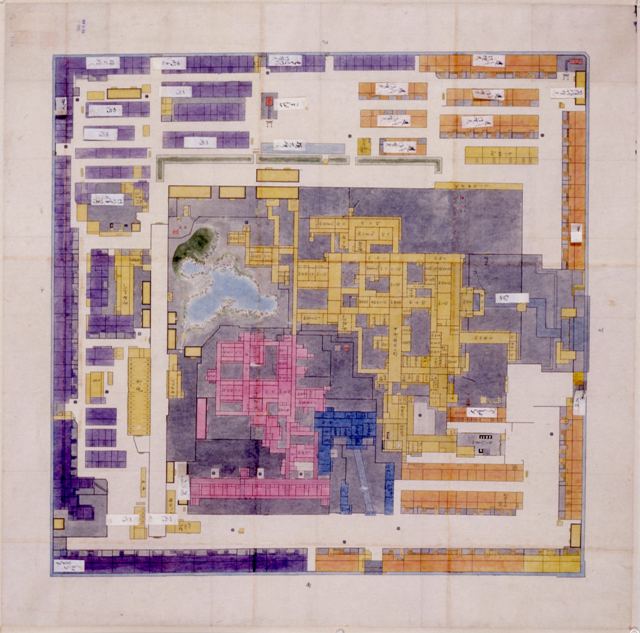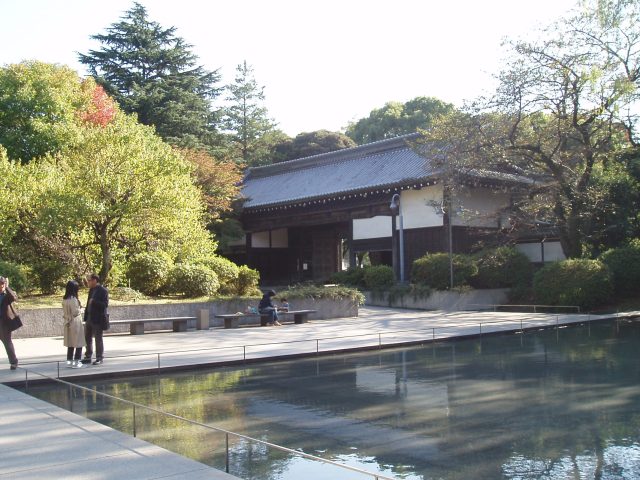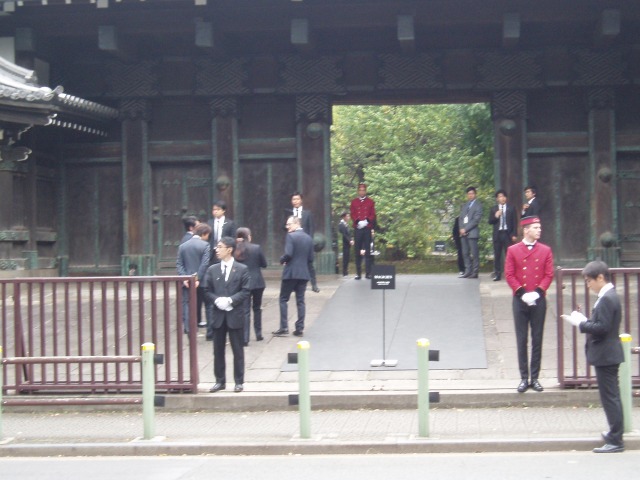When I was in the second grade of elementary school one day I observed a big black and old fashioned gate suddenly appeared on the left side of the main entrance of Tokyo National Museum.At that time the gate did not interest me so much although I was a little surprised by the oppressive appearance. I did not understand the historical value of the gate at all.Recently I have joined as tour guide in Ueno park and thereby I became curious to know the historical background of the gate.It can be seen from the road running north-south across the Ueno Park.The roof on the gate is a gabled and hipped style with horizontal long top-ridge.Two sentry boxes with elegant bow roofs are symmetrically arranged on the both side of the gate. In between there is closed hinged double doors making us to feel very imposing and powerful construction. The surface of the doors and the gateposts are decorated with metal ornaments in the shape of female’s breast (called Nyubyou in Japanese). The gate is showing us a status and dignified appearance and even overwhelming power. It has an outstanding presence which is solemnly separating the inside from the outside space. The gate is designated as an important cultural asset.

Principal Resident of Feudal Lord Ikeda Family in Edo City.
Presented by Tottori Prefectural Museum
This gate was originally located in front of the principal residence of Ikeda Family in Edo city. It is estimated to be built up in the late Edo period more than 150 years ago.The Ikeda family is a feudal lord who governed two counties called Inshuu and Houki(current a part of Tottori prefecture) which yielded 325,000 Koku volume of rice in a year.One “Koku” stands for the weight of rice equivalent to approximate 150 Kgs. Given that the price for 150 Kgs of rice is calculated based on current rice price index,the cost of one Koku can be converted to 75,000 in Jp Yen. Therefore the 325,000 Koku of rice might come to 24,375,000,000 in Jp Yen equivalent to 243,750,000 in US Dollar. It can be considered that Ikeda family owned their domain which yielded that amount of rice. By the way Government tax was paid by rice under Tokugawa Government in Edo period. The Ikeda family was especially treated by Tokugawa Shogunate among feudal lords across the country since one of their family member married a daughter of the first shogun Ieyasu Tokugawa. They became to be family-related lord of Tokugawa and thereby they were allowed to call themselves Sur name of Matsudaira which was the patrilineal Tokugawa family’s name and also to use the family crest of Tokugawa(Three leaves of Hollyhock)
This gate was standing as the main entrance at the principal residence of Ikeda family in feudal lord’s quarter near Edo castle (current emperor’s palace), where the Imperial theater is currently located.After The Meiji Restoration the residence was used as head quarter of army for a time.In 1891 the gate was shifted to the palace of prince Takamatsuno-Miya. And then it was finally moved to the Tokyo National Museum in 1954. Since then it has been displayed for the public in the garden of the museum.A feudal lord, his vassals, their families and their followers were living in the residence in Edo Era.And there used to be the extensive grounds covering 44,800 square meters (Approx.210M x 210M) behind the gate where a luxurious residence of Ikeda family existed. The number of people lived in the residence was presumably more than 1,000.Through Edo Era, Tokugawa Shogunate ordered all of the feudal lords to offer a military service to the Shogun in alternative-year in Edo city, so called “Sankin Kotai”(alternate residence in Edo). Because of the policy, every feudal lord had to move periodically between Edo city and his domain, specifically living alternate years in each place. His wife and his heritor were requested to stay in Edo as hostage while he was away From the residence. A number of soldiers and their attendants were required to accompany the feudal lord on the procession to and from.The feudal lord had to spend a large amount of expenditures to maintain gorgeous residences in both places and to carry out the costly procession to and from Edo. This brought about very heavy financial strains on feudal lords and they could not attempt rebellion towards Tokugawa Shogunate. While the feudal lord was absent, a chief retainer was in charge of administration management in the residence on behalf of his master and of communication with Tokugawa Shogunate and his master in his domain.The residence in Edo was used not only for the lord’s private purpose but also for his formal liaison office in Edo. The extraterritoriality in the residence was approved by Shogunate. Even if some criminals escaped into the site, Shogunate was unable to execute the criminal investigation.
“Buke-Yasiki” with Shoin-style arrangement.
During Edo Era Tokugawa Shogunate regulated the location & size of lords’ residence and its architectural style and fittings to the feudal lords depending on their class and state in the social hierarchy. Among those feudal lords, Ikeda family was ranked higher and distinguished. His residence was outstandingly luxury in feudal lords’ quarter. The drawing room quarter was arranged on the front side of the building and the private on the rear side.It was a typical traditional style of Japanese residential architecture, so called “Buke-Yasiki” with Shoin-style arrangement. The gate was solemnly standing in front of the residence.


Special Event in session
It is one of the scarce remnant repositories which are enabling us to imagine an old-fashioned building and the style of people’s life in Edo period. The gate has recently been utilized for special exhibition held by renowned French Jeweler Cartier in Hyokeikan pavilion in Tokyo National Museum. The visitors perhaps will experience the atmosphere of good old days when they pass through the gate.
